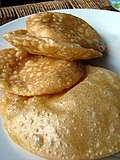Indian bread
Indian bread is a term used to describe a variety of breads native to the Indian subcontinent. These breads are an integral part of Indian cuisine and are consumed in various forms across the country. The most common types of Indian bread include roti, naan, paratha, and dosa, among others.
Types of Indian Bread[edit]
Roti[edit]
Roti is a round, flat bread made from whole wheat flour. It is a staple food in many parts of India and is typically served with a variety of curries and vegetables.
Naan[edit]
Naan is a leavened, oven-baked flatbread. It is thicker than roti and is often served with rich, spicy dishes like butter chicken or paneer tikka.
Paratha[edit]
Paratha is a flaky, layered bread that is typically pan-fried. It can be stuffed with a variety of fillings, including potatoes, spinach, and paneer.
Dosa[edit]
Dosa is a thin, crispy bread made from a fermented batter of rice and urad dal. It is a popular breakfast dish in South India and is typically served with sambar and coconut chutney.
Preparation Methods[edit]
The preparation methods for Indian breads vary widely, depending on the type of bread and regional preferences. Most breads are either baked, fried, or cooked on a tawa (a flat griddle).
Nutritional Value[edit]
Indian breads are a good source of carbohydrates, providing energy for the body. Whole wheat breads like roti also provide dietary fiber. However, some breads, like paratha, can be high in fat due to the use of ghee or oil in preparation.
Cultural Significance[edit]
Indian breads hold significant cultural importance in India. They are often used in religious ceremonies and are a staple at most meals.
Ad. Transform your life with W8MD's Budget GLP-1 injections from $75


W8MD offers a medical weight loss program to lose weight in Philadelphia. Our physician-supervised medical weight loss provides:
- Weight loss injections in NYC (generic and brand names):
- Zepbound / Mounjaro, Wegovy / Ozempic, Saxenda
- Most insurances accepted or discounted self-pay rates. We will obtain insurance prior authorizations if needed.
- Generic GLP1 weight loss injections from $75 for the starting dose.
- Also offer prescription weight loss medications including Phentermine, Qsymia, Diethylpropion, Contrave etc.
NYC weight loss doctor appointmentsNYC weight loss doctor appointments
Start your NYC weight loss journey today at our NYC medical weight loss and Philadelphia medical weight loss clinics.
- Call 718-946-5500 to lose weight in NYC or for medical weight loss in Philadelphia 215-676-2334.
- Tags:NYC medical weight loss, Philadelphia lose weight Zepbound NYC, Budget GLP1 weight loss injections, Wegovy Philadelphia, Wegovy NYC, Philadelphia medical weight loss, Brookly weight loss and Wegovy NYC
|
WikiMD's Wellness Encyclopedia |
| Let Food Be Thy Medicine Medicine Thy Food - Hippocrates |
Medical Disclaimer: WikiMD is not a substitute for professional medical advice. The information on WikiMD is provided as an information resource only, may be incorrect, outdated or misleading, and is not to be used or relied on for any diagnostic or treatment purposes. Please consult your health care provider before making any healthcare decisions or for guidance about a specific medical condition. WikiMD expressly disclaims responsibility, and shall have no liability, for any damages, loss, injury, or liability whatsoever suffered as a result of your reliance on the information contained in this site. By visiting this site you agree to the foregoing terms and conditions, which may from time to time be changed or supplemented by WikiMD. If you do not agree to the foregoing terms and conditions, you should not enter or use this site. See full disclaimer.
Credits:Most images are courtesy of Wikimedia commons, and templates, categories Wikipedia, licensed under CC BY SA or similar.
Translate this page: - East Asian
中文,
日本,
한국어,
South Asian
हिन्दी,
தமிழ்,
తెలుగు,
Urdu,
ಕನ್ನಡ,
Southeast Asian
Indonesian,
Vietnamese,
Thai,
မြန်မာဘာသာ,
বাংলা
European
español,
Deutsch,
français,
Greek,
português do Brasil,
polski,
română,
русский,
Nederlands,
norsk,
svenska,
suomi,
Italian
Middle Eastern & African
عربى,
Turkish,
Persian,
Hebrew,
Afrikaans,
isiZulu,
Kiswahili,
Other
Bulgarian,
Hungarian,
Czech,
Swedish,
മലയാളം,
मराठी,
ਪੰਜਾਬੀ,
ગુજરાતી,
Portuguese,
Ukrainian














